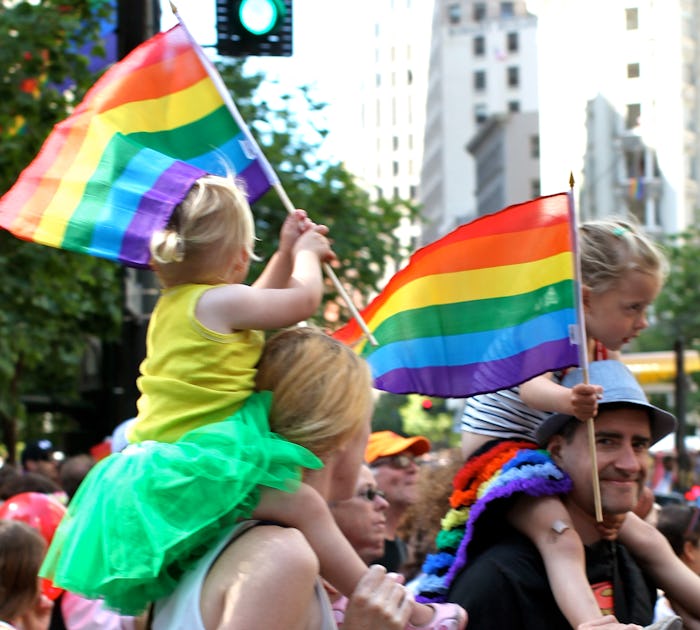Life

How To Raise A Queer-Friendly Child Who Knows All Love Is Equal
As a woman in a seemingly traditional-looking marriage, I think about how to raise my child to be accepting of people who are different than she is. Generally, I think not saying hateful, discriminatory things is a good place to start, but I’m also not naive enough to think that’s enough to raise a tolerant and open-minded little person. And as someone who thinks that social justice and equality are incredibly important, and as a queer person myself, I strive raise a queer-friendly child.
With marriage equality passing nationwide, it’s easy to think that everyone is accepting of LGBTQ people now. Even our president has been a vocal supporter of gay rights. But, as the fact that people can still be fired for being gay in 28 states indicates, the fight for equality is not over. Queer people, particularly queer and trans people of color, still face high rates of harassment, suicide, homelessness, and substance abuse. Acceptance of queer people is about more than just raising a child who is nice; it is about creating a world where LGBTQ people can live without fear of violence or marginalization. People’s lives are at stake. “Diversity” is not a trendy buzzword, and teaching “tolerance” is a slap in the face of the people whose humanity is seemingly up for debate when other people get to determine whose lives are “acceptable.”
Changing the world starts at home, and it begins with teaching your children that queer people are not only OK, but fully human and deserving of the same love and respect as everyone else. And who knows, you may be raising a queer child yourself, and by teaching acceptance in your home, you’re also letting your kid know that you will accept them, whoever they are.
1Have Queer Friends
If you’re not queer-friendly (literally), it’s hard for your kids to be. Are all your friends straight? If so, ask yourself why. If you live somewhere that you just happen to not know any queer people, find other ways to diversify your circle of freinds, even if those friends are online. If you have queer friends, your kids are more likely to, too.
2Don’t Talk About Queerness As “Other”
Instead of talking about queerness as “other,” try to express that it is a totally valid lifestyle. It also means, in my house, that I will not hide my queerness from my child. It would be easy for her to assume that queerness doesn’t exist in our house, since I am a cisgender woman married to her father, who is a cisgender man. But by coming out to my kid, it’s a reminder that she knows and loves queer people, and that queerness doesn’t define a person; it’s just another thing about them.
3Read Books With LGBTQ Characters
If you live in a house where queerness is not readily visible, having a book selection with queer characters helps normalize it and present it as just another family structure. In our house, we love And Tango Makes Three, about the male penguins at Central Park that raised a baby together, and The Purim Superhero, about a little boy who dresses as a superhero for purim at his school and just happens to have two dads. We’re also fans of The Family Book, which shows many different family structures.
4Watch TV That Shows Showcase Queer People
There are far less options for queer representation on children’s shows than there should be. Steven Universe does a fantastic job of showcasing queerness, as does Adventure Time, though both skew a bit older. There’s also the web series SEZ ME. For younger kids, check out this list on Designer Daddy.
5Don’t Assume Their Heterosexuality (Or Cisgenderness)
Being inclusive means not treating heterosexuality as the default, or assuming someone is straight unless they say otherwise. That means not assuming that if your child is a boy, they will have crushes on girls, or visa versa. It also means teaching them not to assume anyone else’s heterosexuality, either. You can say things like, “Some people like girls, some people like boys, some people like everyone.” When they’re older, you can have more nuanced conversations about gender and sexuaity.
6Bring Them Places With Non-Traditional Families
Does their preschool or school have families with families that look different from yours? If it’s possible, seek one out that does. If it’s not, show them examples of queer families in the media, like Neil Patrick Harris and David Burtka’s family.
7Talk Openly About The Challenges Facing Queer Kids
Teach your child that, according to the Center For American Progress, queer youth are more likely to be homeless or attempt suicide. Tell them that queer kids are more likely to be bullied. Explain why that is, and then teach them that it’s their responsibility to do something about it if they see it happening.
8Support Organizations Doing Work In The LGBTQ Community
Make it a point to donate time or money to organizations that are working towards liberation in the queer community. The Trevor Project supports queer youth who are considering suicide, the Audre Lorde Project does amazing work in New York City. Do what you can to give back and help shape the world into the one you want to see.
9Don’t Be A Jerk
If you’re a jerk, your kid will probably be a jerk. So remember that no one’s humanity is up for debate, and teach your child the same.
Images: Courtesy of torbakhopper/Flickr; Giphy (9)